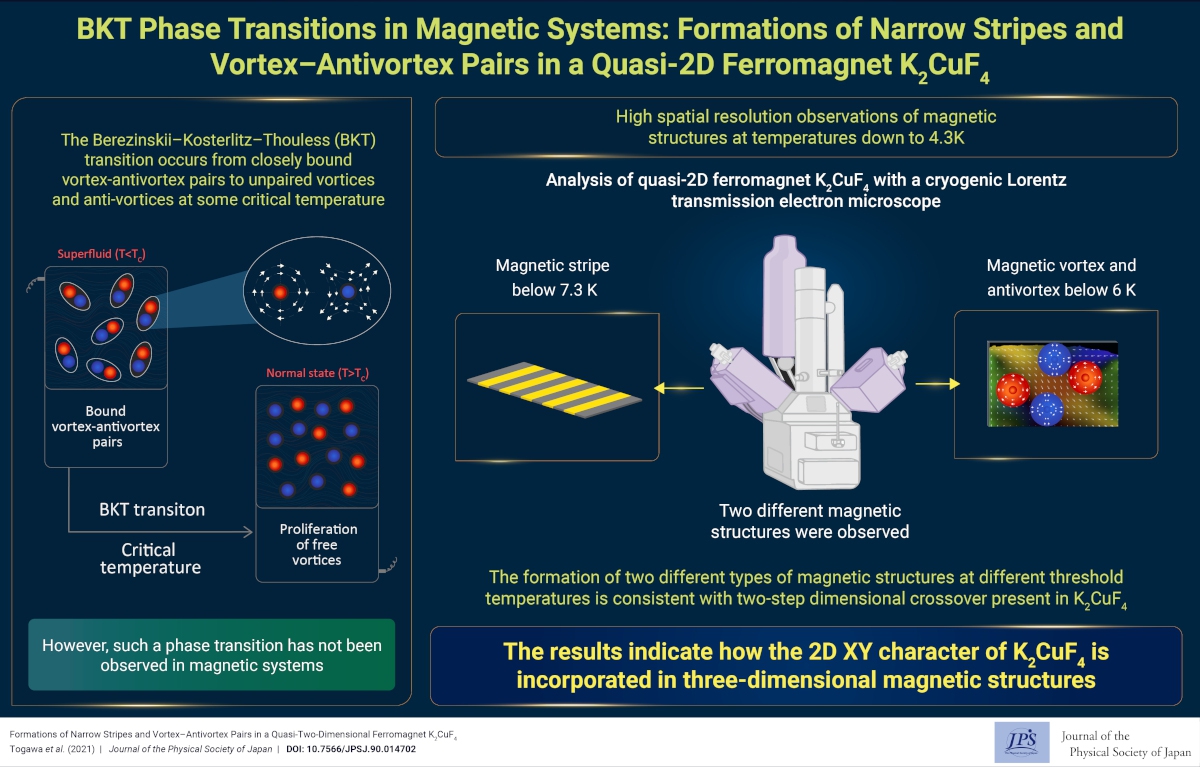BKT Phase Transitions in Magnetic Systems: Formations of Narrow Stripes and Vortex–Antivortex Pairs in a Quasi-2D Ferromagnet K2CuF4
© The Physical Society of Japan
This article is on
Formations of Narrow Stripes and Vortex–Antivortex Pairs in a Quasi-Two-Dimensional Ferromagnet K2CuF4
(JPSJ Editors' Choice)
J. Phys. Soc. Jpn.
90,
014702
(2021)
.
Cryogenic Lorentz transmission electron microscopy directly shows that vortex and antivortex pairs emerge in a quasi-two-dimensional ferromagnet K2CuF4. This work may reveal the nature of Berezinskii, Kosterlitz, and Thouless phase transition in a magnetic system.
Formations of Narrow Stripes and Vortex–Antivortex Pairs in a Quasi-Two-Dimensional Ferromagnet K2CuF4
(JPSJ Editors' Choice)
J. Phys. Soc. Jpn.
90,
014702
(2021)
.
Share this topic
Fields
Related Articles
-
Qualitative Changes in Kinetic Pathways Driven by Hydrodynamic Interactions in Dense Colloidal Suspensions
Cross-disciplinary physics and related areas of science and technology
Statistical physics and thermodynamics
Structure and mechanical and thermal properties in condensed matter
2025-4-18
Even in dense colloidal suspensions, where long-range hydrodynamic interactions are screened, near-field hydrodynamic interactions qualitatively influence the selection of kinetic pathways.
-
Higher-Order Topological Phases in Magnetic Materials with Breathing Pyrochlore Structures
Electronic structure and electrical properties of surfaces and nanostructures
Magnetic properties in condensed matter
Mathematical methods, classical and quantum physics, relativity, gravitation, numerical simulation, computational modeling
2025-4-7
A simple example of a higher-order topological phase, in which the symmetry decreases step-by-step from the bulk to the corner, is realized in a magnetic system with a pyrochlore structure and is characterized by a series of quantized Berry phases defined for the bulk, surface, and edge.
-
Existence of Chiral Soliton Lattices (CSLs) in Chiral Helimagnet Yb(Ni1-xCux)3Al9
Magnetic properties in condensed matter
2025-4-1
Our study examines the magnetic structure of the monoaxial chiral helimagnet Yb(Ni1-xCux)3Al9, providing first direct evidence of the formation of chiral soliton lattice state.
-
Exploring the Vibrant Interplay of Machine Learning and Physics
Cross-disciplinary physics and related areas of science and technology
Electron states in condensed matter
Elementary particles, fields, and strings
Mathematical methods, classical and quantum physics, relativity, gravitation, numerical simulation, computational modeling
Statistical physics and thermodynamics
Superconductivity
2025-3-13
This Journal of the Physical Society of Japan Special Topics edition explores how physics and machine learning complement each other and can solve unresolved problems in physics.
-
Understanding Pressure-Induced Superconductivity in CrAs and MnP
Magnetic properties in condensed matter
2025-3-10
This study reviews existing research on the pressure-induced variation of magnetic properties of transition metal mono-pnictides like CrAS, MnP, and others, aiming to understand the unconventional superconductivity observed in CrAs and MnP.





